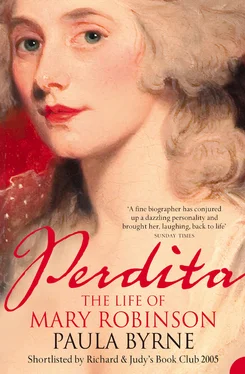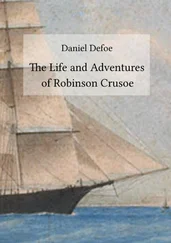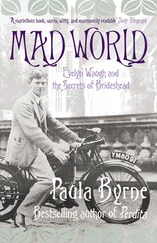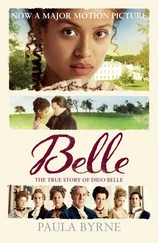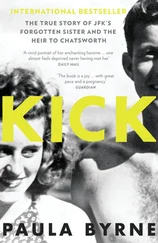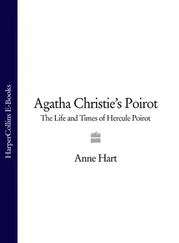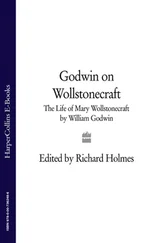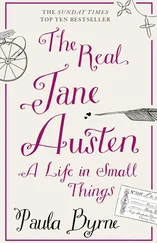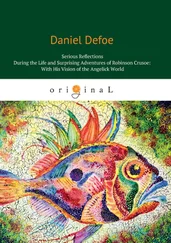Mary was moved to a more orthodox boarding school in Battersea, run by a less colourful but nevertheless ‘lively, sensible and accomplished woman’ named Mrs Leigh. 26 Nicholas Darby then stopped sending money for his children’s education. The resolute Hester took matters into her own hands and set up her own dame school in Little Chelsea. The teenage Mary became a teacher of English language, responsible for prose and verse compositions during the week and the reading of ‘sacred and moral lessons, on saints’-days and Sunday evenings’. 27 Readers of her Memoirs would have been at best amused at the idea of one of the most notorious women of the age presenting herself as a teacher of morals and religion. Mary also had responsibility for supervising the pupils’ wardrobes, and making sure that they were properly dressed and undressed by the servants.
In 1770, Nicholas Darby ran into more problems. Just as he had a thousand pounds’ worth of seal skins ready for market, a British military officer arrived at his Labrador fishery and confiscated all his produce and tackle on the grounds that he was illegally employing Frenchmen and using French rather than British equipment. He was left marooned. He eventually made it back to London and asked the Board of Trade for compensation, claiming that he did not know that his Canadian crew were actually French subjects. The Board of Trade passed the buck, saying it had no jurisdiction in the case. Nicholas had a moral victory when the Court of King’s Bench awarded him £650 damages against the Lieutenant who had seized the goods, but the money was uncollectible. In the circumstances, one might have expected him to be grateful for his estranged wife’s initiative in establishing a school. But he was a proud man: ‘he considered his name as disgraced, his conjugal reputation tarnished, by the public mode which his wife had adopted for revealing to the world her unprotected situation’. 28 He lived openly with his mistress, but could not abide seeing his wife publicly revealed as someone akin to an impoverished widow or spinster. He demanded that the school be closed immediately. It had lasted for less than a year.
Hester and her children moved to Marylebone. Like Chelsea, this was an expanding village on the edge of London, but it had a less rural feel and was fast being recognized as an integral part of the metropolis. Mary reverted from teacher to pupil, finishing her education at Oxford House, situated near the top of Marylebone High Street, bordering on Marylebone Gardens. Nicholas Darby and his mistress Elenor settled in the more fashionable and gentrified Green Street, off Grosvenor Square in Mayfair, a district that was becoming increasingly popular with merchants and rich shopkeepers as well as the gentry.
Mary must have been acutely conscious of the differences in lifestyle between her mother and her father. She sometimes accompanied her father on walks in the fields nearby, where he confessed that he rather regretted his ‘fatal attachment’ to his mistress – they had now been together so long and been through so much that it was impossible to dissolve the relationship. On one of their walks, they called on the Earl of Northington, a handsome young rake and politician, whose father had been one of the sponsors of Darby’s Labrador schemes. They were very well received, with Mary being presented as the goddaughter of the older Northington (now deceased). In later years, she did not deny rumours that she might have been the old Lord’s illegitimate daughter. The young Lord, meanwhile, treated her with ‘the most flattering and gratifying civility’. 29
When Nicholas returned to America, Hester moved her children to Southampton Buildings in Chancery Lane. This was lawyers’ territory, backing onto Lincoln’s Inn. She had placed herself under the protection of Samuel Cox, a lawyer. Perhaps she had applied to him for legal help after the separation from Nicholas became final. Being ‘under the protection’ of a man was usually code for sexual involvement, so it may have been more than a professional relationship.
It was during her time at Oxford House that Mary was drawn towards the stage. The governess, Mrs Hervey, spotted her talent for ‘dramatic exhibitions’, and persuaded Hester to let her daughter try for the stage, despite the fact that it was not considered to be a respectable career. Hester was persuaded that there were actresses who ‘preserved an unspotted fame’. Nicholas obviously had his doubts. Upon setting off on his new overseas adventure, he left his wife with a chilling injunction to ‘Take care that no dishonour falls upon my daughter. If she is not safe at my return I will annihilate you.’ 30
The school’s dancing master was also ballet master at the Theatre Royal Covent Garden. Through him, Mary was introduced to an actor called Thomas Hull, who was impressed by her recitation of lines from Nicholas Rowe’s tragedy Jane Shore of 1714. But nothing came of the audition. Mary did not despair and she was rewarded with a much greater opportunity. Her mother’s protector Samuel Cox knew Dr Samuel Johnson and that was enough to open the door of Johnson’s old pupil and friend, David Garrick.
What was Mary Darby like at the time that she met Garrick? Though she may have been a plain child with dark swarthy looks, she had become a very beautiful teenager. She had curly, dark auburn hair and soft blue eyes that were to enchant men from the Prince of Wales to Samuel Taylor Coleridge. She had dimples in her cheeks. But there was always an elusive quality to her beauty. Sir Joshua Reynolds’s pupil, James Northcote, remarked that even his master’s portraits of her were failures because ‘the extreme beauty’ of her was ‘quite beyond his power’. 31
* See Appendix for the uncertainty over the year of Mary’s birth.
CHAPTER 2 A Young Lady’s Entrance into the World
As London is the great emporium of commerce, it is also the centre of attraction for the full exercise of talents, and the liberal display of all that can embellish the arts and sciences.
Mary Robinson, ‘Present State of the Manners, Society, etc.
etc. of the Metropolis of England’
London was like nowhere else in the world. Bigger than any other city in Europe, with a population more than ten times that of Bristol, it was a place of extremes. Riches and squalor, grandeur and wretchedness, appeared cheek-by-jowl. This was an era of unprecedented consumerism: for companionship and entertainment there were coffee houses, taverns, brothels, parks, pleasure gardens, and theatres. Above all there were shops. Napoleon had good reason to dismiss the English as a nation of shopkeepers. By the time of Mary’s arrival in the metropolis, London had one for every thirty residents. Oxford Street alone boasted over a hundred and fifty. Everything was on display, from plate laden in silversmiths’ shops to fruits and spices piled high on street-barrows. Tea, coffee, sugar, pepper, tobacco, chocolate, and textiles – the ‘fruits of empire’ – were sold in vast quantities. 1 There were print shops, book shops, milliners, linen drapers, silk mercers, jewellery shops, shoe shops, toy shops, confectioners. London was the epicentre of fashion, a place to gaze and be gazed at. It was an urban stage, and few understood this as well as Mary.
For the young poet William Wordsworth, London’s inherent theatricality was disturbing. His section on ‘Residence in London’ in his autobiographical poem The Prelude describes with unease ‘the moving pageant’, the ‘shifting pantomimic scenes’, the ‘great stage’, and the ‘public shows’. For Wordsworth, the gaudy display and excessive showiness of the city signalled a lack of inner authenticity; ‘the quick dance of colours, lights and forms’ was an alarming ‘Babel din’. 2 Mary Robinson also captured the cacophony of urban life in her poem ‘London’s Summer Morning’, but she relished what Wordsworth abhorred:
Читать дальше
